My web
VA Loan
![]()
This document explains the specific steps for entering certain data for a VA loan casefile. This document is not intended to provide detailed instructions for entering all the loan application data in Desktop Underwriter® (DU®).
-
For the loan casefile you want to submit as a VA loan, click section L3. Mortgage Loan Information in the navigation bar.
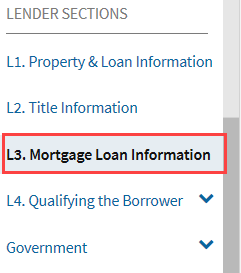
-
In the L3. Mortgage Loan Information screen, click the Edit icon.
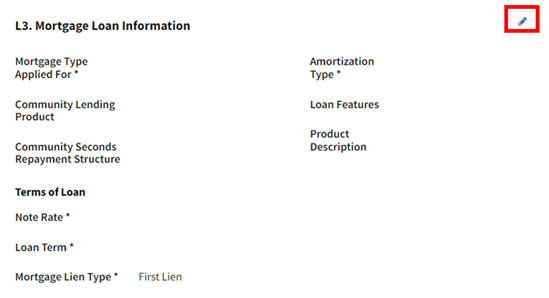
- From the Mortgage Type Applied For drop-down list, select VA.
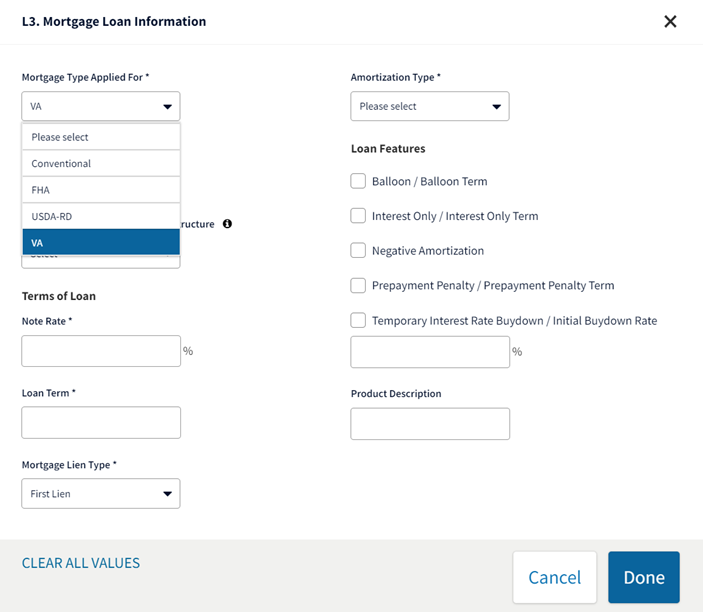
Note: The First Lien drop-down list option in the Mortgage Lien Type field is the only one supported for VA loan casefiles. Also, the Balloon, Interest Only, and Negative Amortization loan features are not allowed on VA loan casefiles.
-
Expand the 1. Borrower Information section in the navigation bar and click Personal Information.
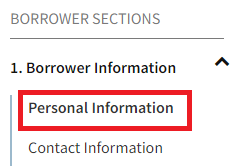
-
In the 1a. Personal Information screen, click the Edit icon.
-
Enter the personal information for each borrower, including Citizenship, Number of Dependents, and the Dependent Age. The Dependent Age filed only appears if number of dependents is greater than and 0. There will be a separate Dependent Age field for each dependent.
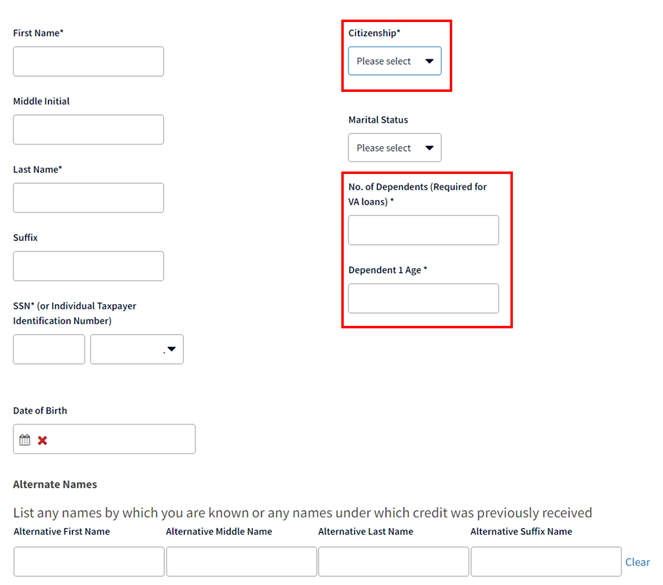
Notes: For VA loans, the number of borrowers cannot exceed two.
The No. of Dependents field is required for both the borrower and the co-borrower. List each dependent only once, under either the borrower or the co-borrower. If a borrower has no dependents, enter 0.
If the subject property is in a non-community property state and the veteran’s spouse is not included on the loan application, be sure to include the spouse as a dependent.
-
Expand the 1. Borrower Information section in the navigation bar and click Gross Monthly Income.
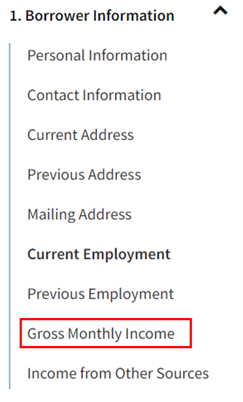
-
In the Current Gross Monthly Income screen, click the Edit icon and scroll down to enter the borrower’s military income.
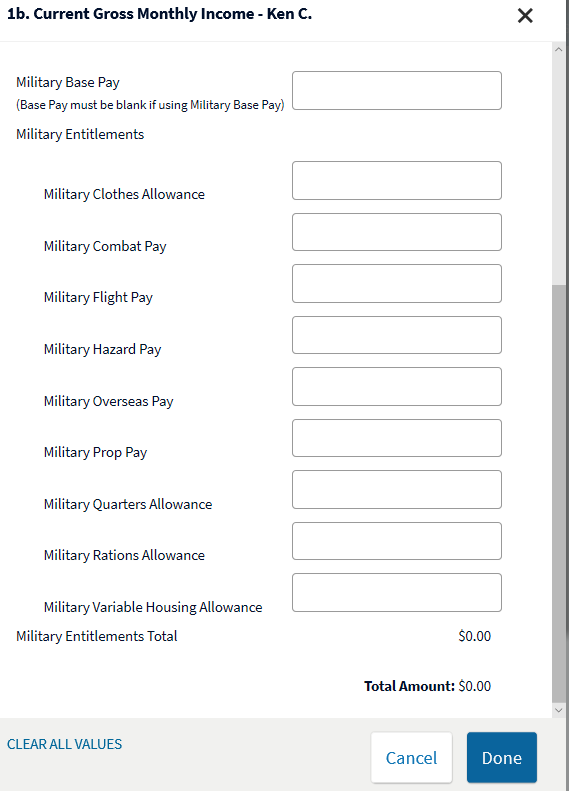
-
If the borrower has other income sources, including VA Benefits Non-Educational income and/or Mortgage Credit Certificate (MCC) income, expand the 1. Borrower Information section in the navigation bar and click Income from Other Sources.

-
Click the Edit icon.
-
Select the Income Source from the drop-down list and enter the Monthly Income amount.
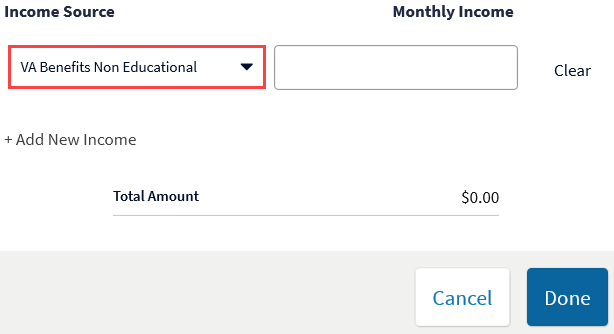
Click +Add New Income as necessary to add additional Income Sources.
Notes: If the borrower has negative net rental income that must be deducted from the income based on VA policy, click +Add New Income and select Other income source. Enter the negative amount in the Monthly Income field. Make sure the rental amount(s) are not also entered in the 3. Real Estate Owned section.
The following income types are used for conventional loans only and in most cases result in an error if selected for VA loans; and, in all cases the income amount will not be used in underwriting: Accessory Unit Income, Capital Gains, Employment Related Account, Housing Allowance, Housing Choice Voucher Program,Non-Borrower Household Income,Public Assistance,Royalties,Separate Maintenance,Temporary Leave, and Tip Income. In addition,Foreign Income andSeasonal income, which are entered on the 1b. Current Employment/Self Employment and Income screen, will result in an error.
-
If the borrower owns real estate, select 3. Real Estate Owned to add those properties to the loan application.
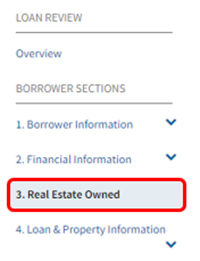
-
In Section 3: Real Estate Owned, click ADD PROPERTY.

- The section will expand. Click the Edit icon next to Property Information.
-
Complete the applicable fields in the Property Information screen:
a. If none of the borrowers, own any real estate, check the I do not own any real estate box.
b. Enter the street address fields for the property.
c. Select the Current Occupancy from the drop-down list.
d. Select the Intended Occupancy of that property from the drop-down list. Other is not a valid selection for government loans.
e. If the property is the subject property, place a check mark in the This is the subject property field.
f. Choose the borrower that owns the property from the Borrower(s) That Own Property drop-down list. If there is a liability for this property in section 2c.Liabilities - Credit Cards, Other Debts, and Leases that You Owe, make sure the Account Owner selected for the liability matches the borrower here in Borrower(s) That Own Property.
g. Enter the Property Value, whether Estimated or Appraised in the appropriate field.
h. Select the Status of that property from the drop-down list.
i. If the insurance, taxes, and other fees are not included in the monthly mortgage payment for the property section 2c. Liabilities - Credit Cards, Other Debts, and Leases that You Owe, include them in the Monthly Insurance, Taxes, Association Dues, etc., field.
Once you have finished entering the applicable data, click Done.
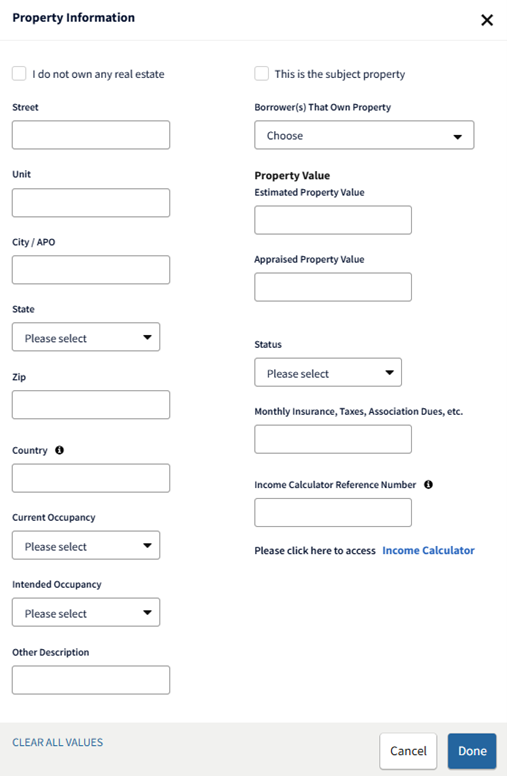
- Click the Edit icon next to Mortgage Loans on Property.
- Enter the editable information for the mortgage(s) and/or HELOC(s). If the existing mortgage loan is an FHA loan, select FHA in the Type (FHA only) drop-down list.

Note: Most of the fields on this screen can only be entered and/or edited on the 2c. Liabilities - Credit Cards, Other Debts, and Leases that You Owe screen.
- If there is rental income associated to the property, click the Edit icon next to For 2-4 Unit Primary or Investment Property Only to enter the applicable data. Refer to the Navigating Loan Application Fields job aid for additional information about entering rental income.

- If there are additional Real Estate Owned properties, repeat steps 13 through 16.
Note: If the transaction is a refinance, the subject property should be entered first.
- Click section 4. Loan & Property Information in the navigation bar.
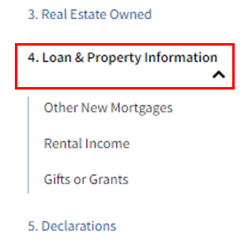
- In section 4a. Loan & Property Information, select the Loan Purpose. If Refinance is selected, the Purpose of Refinance field will appear. Limited Cash Out is not a valid option for VA loans in DU.
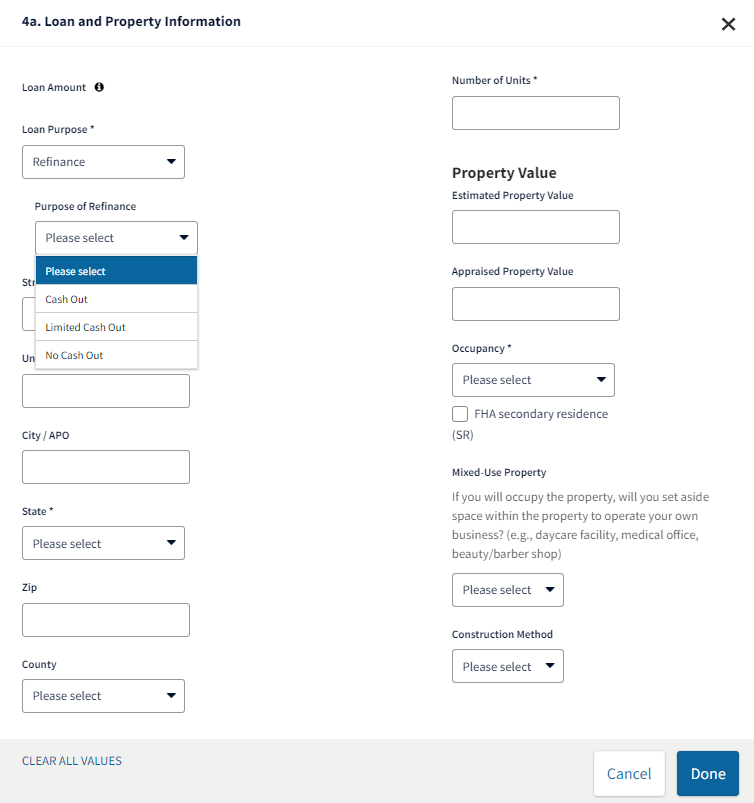
- If a gift will be used, click Gifts or Grants.
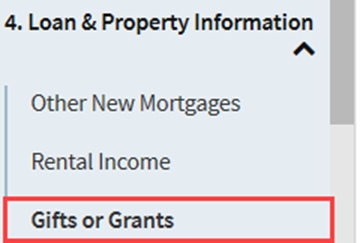
- In the 4d. Gifts or Grants You Have Been Given or Will Receive for this Loan screen, click the Edit icon.
- Complete the applicable fields:
a. Choose the borrower who owns the account in the Account Owner field.
b. Select Cash Gift in the Asset Type drop-down list.
c. Select the applicable provider from the Source drop-down list.
d. Enter the total amount in the Cash or Market Value field. The full amount of the gift must be entered.
e. If the gift or grant has been deposited in an asset account (i.e., savings account), select Yes in the Deposited field. If the gift or grant has not been deposited in an asset account, select No in the Deposited field.
f. If there is more than one gift, click +Add Gift or Grant and repeat steps a. through e.
Note: The full amount of the gift(s) needs to be entered.

- To enter the VA Funding Fee, click section L4. Qualifying the Borrower in the navigation bar.
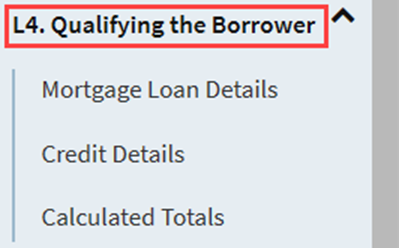
- In the L4. Qualifying the Borrower - Minimum Required Funds or Cash Back screen, click the Edit icon.
- Enter the entire VA funding fee amount in the PMI, MIP, Funding Fee field.

- Expand section L4. Qualifying the Borrower in the navigation bar and click Mortgage Loan Details.
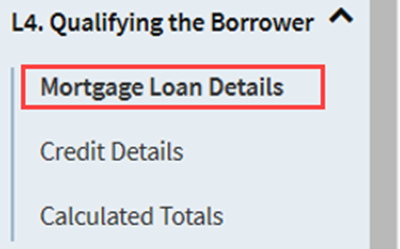
- In the L4. Mortgage Loan Details screen, click the Edit icon.
- Enter the amount of the VA funding fee that will be financed in the Financed Mortgage Insurance (or Mortgage Insurance Equivalent) Amount field (the second amount field for line I).
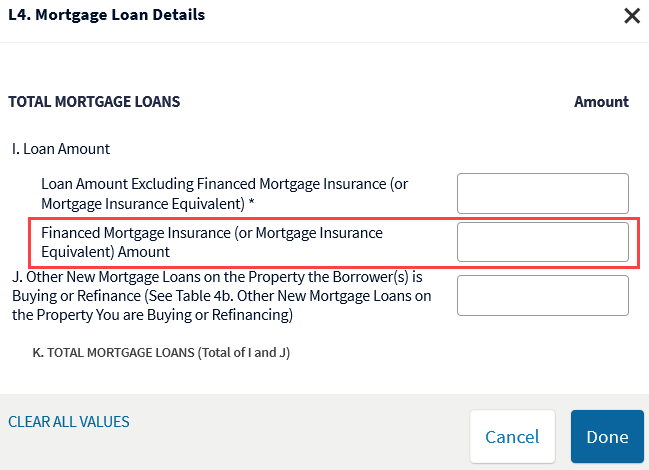
- Expand the Government section in the navigation bar and click FHA & VA Loans.

- For the first screen in FHA and VA Loans, click the Edit icon. The following fields apply to a VA loan casefile. Enter any applicable data.
- Mortgage Credit Certification (MCC)- An amount entered in the Mortgage Credit Certificate (MCC) field is added to the residual income.
- Seller Concessions - Enter the dollar amount of seller concessions in excess of the VA's limitation, if you have not already reduced the loan amount by the amount of the seller concession.
- Agency Case Number - Complete the Agency Case Number field by the final submission. An agency case number is not required to receive an underwriting recommendation, but you must enter an agency case number before you submit the loan to VA for guaranty.
- Government Refinance Type - If you are doing a refinance transaction, select the Government Refinance Type from the drop-down list. This field is required to be completed for VA refinance transactions.
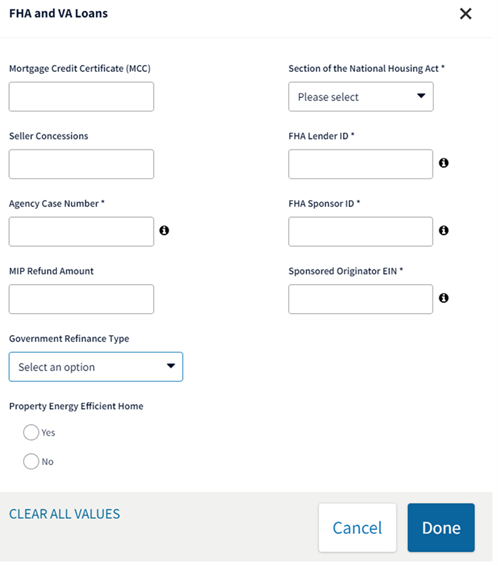
- If you have the CAIVR number, click the Edit icon for the second screen in FHA and VA Loans.
-
Enter the CAIVR# and clickDone.
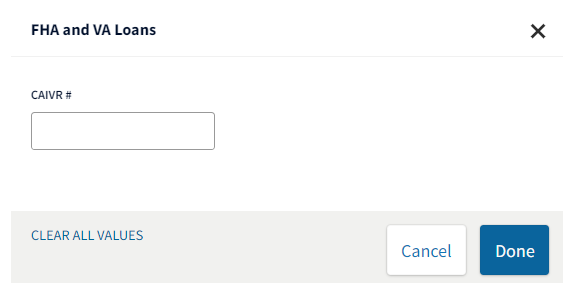
Important: The CAIVR number is not required to submit a loan for an underwriting recommendation, but it is required to obtain VA guaranty.
- Click VA Loans Only in the navigation bar.

- For the first screen in VA Loans Only, click the Edit icon.
-
Complete the applicable fields. The borrower and co-borrower must be married to be eligible for VA automated underwriting. If they are not married to each other an Ineligible recommendation will be returned.
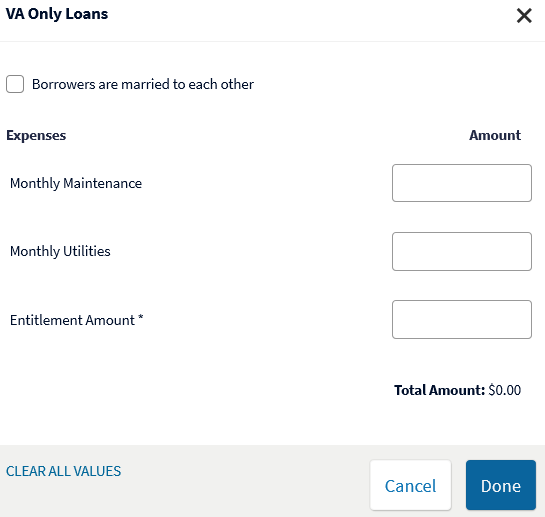
Note: Enter the remaining entitlement shown on the Certificate of Eligibility in the Entitlement Amount field.
- Click the Edit icon for the second screen in VA Loans Only.
-
Enter the monthly amount for all applicable taxes. Federal, state, local, social security tax should all be combined and the total sum should be entered in the Federal Tax field.
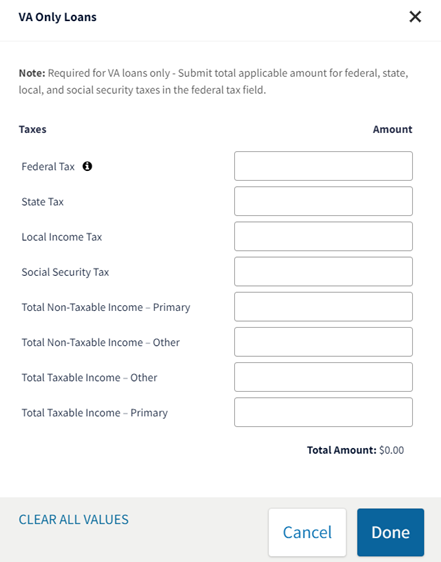
Note: An amount entered in the Total Non-Taxable Income - Primary and Total Non-Taxable Income - Other fields will not be used in underwriting.
In addition to the values/fields mentioned in this job aid, there are some other values/fields on the redesigned Form 1003 that DU for government loans will not use, and those that may be used by DU for government loans in a future release. When existing messages are updated or new messages are added using other new fields, the details will be included in future DU for government loans release notes. As always, you must ensure full compliance with all VA eligibility requirements and all applicable VA policies.